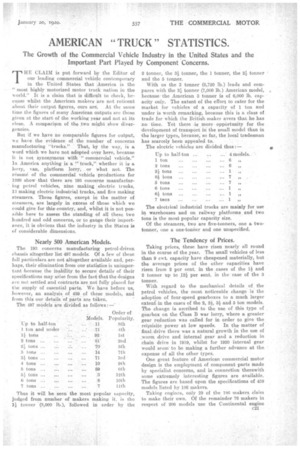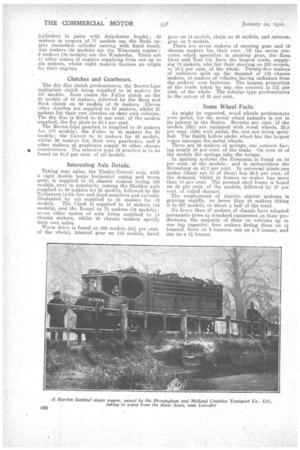AMERICAN " TRUCK " STATISTICS.
Page 9

Page 10

If you've noticed an error in this article please click here to report it so we can fix it.
The Growth of the Commercial Vehicle Industry in the United States and the Important Part Played by Component Concerns.
THE CLAIM is put forward by the Editor of our leading commercial vehicle contemporary in the United States that America is the " most highly motorized motor truck nation in the world," It is a claim that is difficult to check, because whilst the American makers are not reticent about their output figures, ours are. At the same time the figures of many American outputs arc those given at the start of the working year and not at its close. A comparison of the _two might show divergencies.
But if we have no comparable figures for output, we have the evidence of the number of concerns manufacturing "trucks." That, by the way, is a word which we have not adopted over here, he cause it is not synonymous with " commercial vehicle." in America anything is a "truck," whether it is a lorry, van, platform lorry, or what not. The résumé of the commercial vehicle productions for 1920 show that there are 193 concerns manufacturing petrol vehicles, nine making electric trucks, 13 making electric industrial trucks, and. five making steamers. These figures, except in the matter of steamers, are largely in excess of those which we could give for thiscountry, and, whilst it is not possible here to assess the standing of all these two hundred and odd concerns, or to gauge their importance, it is obvious that the industry in the States is of considerable dimensions.
Nearly 500 American Models.
The 193 concerns manufacturing petrol-driven chassis altogether list 497 models. Of a few of these full particulars are not altogether Available and, perhaps, their elimination from our statistics is unimportant because the inability to secure details of their specifications may arise from the fact that the designs a re not settled and contracts are not fully placed for the supply of essential parts. We have before us, however, an analysis of 459 of these models, and from this our details of parts are taken.
The 497 models are divided as follows :—"' Thus it will be seen the most popular capacity, judged from number of makers making it, is the 11 tonner (3,000 lb.), 'followed in order by the 2 tonner, the 31 tonner, the 1 tanner, the 2 -thriller and the 5 tomaer.
With us the 3 former (6,720 lb.) leads and compares with the 31 tonner (7,000 lb.) American model, becausethe American 3 tanner is of 6,000 lb. capacity only. The extent of the effort to cater for the market for vehicles of a capacity of 1 ton and under is worth remarking, because this is a class of trade for which the British maker avers that he has -no time. Yet there i5 more opportunity for the development of transport in the small model than in tho larger types, because, so far, the local tradesman has scarcely been appealed to.
The electric vehicles are divided thus:— Up to half-ton 4 models.
1 ton 6 2 tons 6 21 tons 1 pri tons '7 5 tons 7 6 tons 1 tons 1 7 tens 1 The electrical industrial trucks are mainly for use in warehouses and on railway platforms and two tons is the most popular capacity size.
Of the steamers, two are five-tormers, one a twotonner, one a one-tontier and one unspecified.
The Tendency of Prices.
Taking prices, these have risen nearly all round in. the course of the year. The small vehicles of less than 9 cwt. capacity have cheapened materially, but the average prices of the other capacities have risen from 2 per cent, in the eases of the 11 and 2 tonner up to 121 per sent, in the case of the 3 tanner.
With regard to the mechanical details of the petrol vehicles, the most noticeable change is the adoption of four-speed gearboxes to a much larger exteni in the cases of the 2, 2, 3i and 5 ton models. The change is ascribed to the use •of this type of gearbox on the Class B war lorry, where a greater gear reduction was called for in order to give the re■anisite power at low speeds. In the matter of final drive there was a natural growth in the use of worm drive and internal gear and, a reduction in chain drive in 1919, whilst for 1920 internal gear would seemto be making a further advance at the expense of all the other typed. One great feature of American commercial motor design is the emeIoyment of component parts made by specialist concerns, and in connection therewith some extremely interesting figures are available. The figures are based upon the specifications of 459 models listed by 186 makers.
Taking engines, only 29 of the 186 makers claim to make their own. Of the remainder 76 makers in respect of 206 models use the Continental engine (cylinders in pairs with detachable heads); 33 makers in respect Of 77 models use the Buda engine (monobloc cylinder casting with fixed head). Ten makers (35 models) use the Wisconsin engine; 9 makers (16 models) use the Waukesha. There are 11 other makes of engines supplying from one up to six makers, whilst eight makers disclose no origin for their engines.
Clutches and Gearboxes.
The dry disc clutch predominates, the Brown-Lipe multiplate clutch being supplied to 50 makers for 137 models. Next comes the Fuller clutch on the 88 models of 42 makers, followed by the Borg and Beck clutch on 85 models of 35 makers. Eleven other clutches are supplied to 23 makers, whilst 21 makers list their own clutches on their own vehicles. The dry disc is fitted to 61 per cent, of the models "supplied, the dry plate to 20.4 per cent.
The Brown-Lipe gearbox is supplied to 58 makers for 170 models; the Fuller to 45 makers for 93 models; the Covert to 10 makers for 26 models, whilst 29 makers list their own gearboxes, and 9 other makers of gearboxes supply 38 other chassis
• constructors. The selective type of gearbox is to be found on 84.5 per cent. of all -models.
Interesting Axle Details.
Taking rear axles, the Timkin-Detroit axle, with a rigid double banjo horizontal casing and worm gear, is supplied to 53 chassis makers listing 150 models, next in popularity coming the Sheldon axle supplies to 26 makers for 85 models, followed by the Torbensen (with live and dead members and recently illustrated by us) supplied to 21 makers for 42 models. The Clark is supplied to 16 makers (44 models), and the Russel to 13 makers (19 models); seven other makes of axle being supplied to 15 chassis makers, whilst 30 chassis makers specify their own axles.
Worm drive is found on 296 models (64; per cent. of the whole), internal gear on 116 models, bevel
gear on 14 models, chain on 23 models, and externo.. gear on 2 models.
There are seven makers of steering gear and 19 chassis makers list their own. Of the seven concerns which specialize in steering gear, the Ross Gear and Tool Co. have the largest trade, supplying 76 makers, who list their steering on 233 models, or 50.3 per cent. of the whole. Twenty-five makers of radiators split up the demand of 138 chassis makers, 16 makers of vehicles having radiators from the makers' own factories. The largest proportion of the trade taken by any one concern is 131 per cent. of the whole. The tubular type predominates to the extent of 65 per cent.
Some Wheel Facts.
As might be expected, wood wheels predominate over metal, for the metal wheel industry is yet in its infancy in the States. Seventy per cent. of the models (321) are equipped with wood wheels, 23.3 per cent. (106) with metal, the rest not being specified. The Smith hollow spoke wheel has the largest vogue amongst the metal wheels. • There are 23 makers of springs, one concern haying nearly 18 per cent. of the trade. On over 55 of the models the springs take the torque. In ignition systems the Eisemann is found on 44 per cent. of the models ; and in carburetters the Stromberg on 42.2 per cent. In universal joints one maker (there are 13 of them) has 38.5 per cent. of the demand, whilst in frames no maker has more than 18 per cent. The pressed steel frame is found on 66 per cent. of the models, followed by 27 per cent, of rolled channel.
The . employment of electric starter systems is growing rapidly, no fewer than 85 makers fitting it to 237 models, or a-bout a half of the total.
No fewer than 37 makers of chassis have adopted pneumatic tyres as standard equipment on their pro&aims, the majority of them on vehicles up to one ton capacity, four makers fitting them on 1 tomierg, three on 2 tonners, one on a 3 -Loaner, and one on a 3i tonner.




























